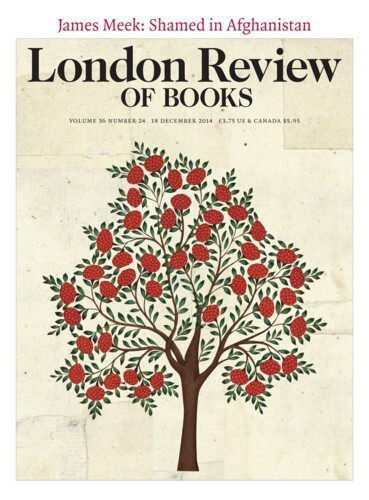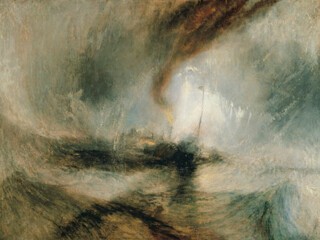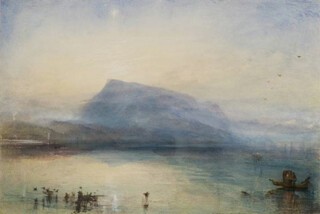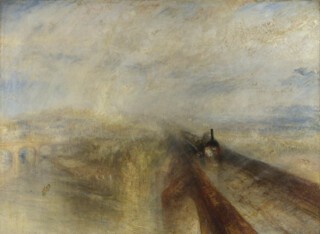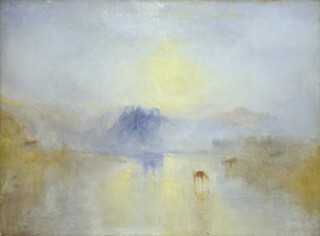After three or four hours in the Linbury Galleries at Tate Britain, examining, admiring, taking notes on the Late Turner exhibition (until 25 January), I wandered into the café to take the weight off my feet and to read the reviews I had downloaded from the exhibition website on my tablet. I had been careful not to read them until after my visit, but now I wanted to see if I could use them to get me started on my own review. The first one I read half-persuaded me that I was just too leaden-eyed, leaden-headed to appreciate late Turner, not at all the right person to be writing this review. ‘Out of the ashes of this Götterdämmerung,’ wrote the scourge of the poppies, Jonathan Jones, of his own exit from the exhibition, ‘I crawled away exhausted, wrecked, into the empty light of the modern world.’ Wow. That is some reaction. After all that mundane examining, admiring, taking notes, I was a touch exhausted myself, but wrecked? I hung my head, dropped my shoulders and tried to feel wrecked. ‘Are you all right?’ a kind lady at the next table asked. I had to admit I was. But what of Jones? Would he recover? How long would it take?
Not long, as it turned out. Over the next four days, wrecked as he was, he managed to write another seven articles and reviews, and over the next month, though exhausted, he kept close to this rate of production, averaging one piece a day. Not for the first time I wondered if he was perhaps guilty of overwriting, in more senses than one. But he was not the only critic to claim to have been physically impaired when confronted by late Turner, or disappointed by the relative colourlessness of the world out in the street compared with the feast of colour in the gallery. ‘Emerging from Turner’s heliocentric cathedral,’ Peter Conrad wrote in the Observer, ‘I felt I had cataracts: it takes time to re-accustom your dazzled eyes to the wan, monochrome mock-up we call reality.’
Turner, and his great advocate Ruskin, would surely have sighed with impatience at these reactions. ‘Always remember,’ Turner advised a young painter, ‘you can never reach the brilliancy of nature’ – however monochrome, empty, nature seems to be. ‘There is no climate, no place, and scarcely an hour,’ Ruskin declared, ‘in which nature does not exhibit colour which no mortal effort can imitate or approach.’ I am being pedantic, I suppose, in taking so literally what Jones and Conrad intended merely as evocative fine writing, or perhaps were hoping might be read as a statement about the moral emptiness of reality and modernity. But where the artist is Turner, and the topic is light, about which he thought with such precision, to use hyperbole like this is surely to miss the point.
Missing the point of Turner, and how for half a century critics have been doing just that, is what this exhibition is about. In a superb introductory essay in the catalogue, Sam Smiles questions what has become a much repeated and unhelpful notion about Turner’s last works, a notion that has been seen as ‘righting a great wrong’. It presumes that in his last years, aware of how little time was left to him, Turner at last painted for his own satisfaction, not for that of the public or of his patrons. He now creates ‘valedictory works that are far beyond his contemporaries’ understanding but look forward to posthumous vindication in a world finally ready to accept them’. Only when ‘the tide of modern art had flooded in’ were we able to see that these late works anticipated Impressionism and even abstraction. ‘Turner, on this analysis, is an exceptional artist not merely because of his high ability and the production of so many outstanding paintings throughout his professional career, but because those pictures he painted in the later 1830s and 1840s break the bonds of time and history to which lesser artists submit.’ Painting set free.
That phrase, the subtitle of this exhibition, was Lawrence Gowing’s, who about fifty years ago came up with the claim that Turner was the first modern artist, perhaps the first abstract expressionist. His view of Turner was based on the recovery of works left rolled up in his studio when he died, kept in storage since his death and regarded as unfinished. These now came to be discussed as if they were finished works, or as if it didn’t matter whether they were finished or not. And of course in one sense it doesn’t. Arguably, none of Turner’s oil paintings should be thought of as finished, except provisionally; as long as they were within reach, they were works in progress, open to indefinite revision. But to reinvent Turner as a modern artist by liberating from storage works he had not thought ready for exhibition, not ready even to be sent to the Academy to be licked into shape on Varnishing Day, is like publishing a writer’s notes for a future novel and claiming they represent a new genre of fiction. It has also had the consequence, Smiles writes, ‘that any serious concern with the subjects and meanings of Turner’s pictures has been set aside to concentrate instead on those aspects of form and composition that seem to presage modern painting’.
Our understanding of Turner, Smiles argues (and it is odd that it needs arguing at all), should start from the fact that his late works were painted anything up to 180 years ago, in the early Victorian period, and addressed to an early Victorian audience. He was an artist fully engaged in his time, anxious to communicate what he believed were important truths about the (then) modern world, but anxious too to sell work and to attract new commissions. His subject matter was not chosen as particularly suitable for formal experiments in abstraction: in his late works ‘he continued to explore visual perception, natural phenomena, modern life, the course of history and the social and ethical contexts that determine the endeavours of mankind’. In short, he was very much attuned to the mid-19th century world, to its economic and technological development, to its concerns with the lessons of history and the nation’s future prospects, to its debates about the contribution of art to civil society and to reflections on the nature of painting.
There was nothing in his interest in social, cultural, ethical questions that he needed to be liberated from, that inhibited his commitment to the art of painting, to ‘handling oil paint and watercolour freely and using the resources of light and colour to choreograph the pictorial structure of his work’. On the contrary, it was the great range of his interest in, and his concern for, the time he lived in that prompted and promoted his ceaseless experimentation with the language of painting.
In the show at Tate Britain therefore, ‘painting set free’ means something like the opposite of what it meant for Gowing. The aim of the co-curators, David Blayney Brown, Amy Concannon and Smiles, is to set Turner’s last paintings free from what Brown calls the ‘reductive critical stereotypes’ that have been applied to his work by those who are determined to ignore its historicity, as if its quality and value somehow depend on its being liberated from the past and all the baggage of the past, its subject matter especially.
Not every reviewer was convinced. This show is ‘flirting with controversy’, complained Fisun Güner writing for the Arts Desk, by attempting to situate Turner in his own time: ‘The curators don’t shy away from calling him a “Victorian artist”, a term which, though of course factually accurate for much of his later life and career, is unavoidably, provocatively, loaded. Who doesn’t flinch a little from the use of such a label, for so long a term of disparagement?’ Imagine calling Bleak House or Jane Eyre ‘Victorian novels’! If we did, who would read them? We should understand Turner instead as a ‘modernist precursor’, for that is the Turner that speaks most directly to us today – the ‘most compelling’ Turner because the ‘most familiar’. God forbid that exhibition curators should try to defamiliarise him.
Jones was more than happy with the exhibition, but no less certain than Güner about which was the real Turner: ‘Here at last is the Turner who matters – the man who invented modern painting.’ He wastes no time attempting to argue with the curators; he has no need to, for they are just ‘art historians’ who ‘smile knowingly’ at the idea that Turner might ever have painted ‘for painting’s sake’, and who believe it might help our understanding of his work to attempt to resituate him in the world he came from. The Tate Britain show ‘drowns such quibbles under a flood of raw wild paint’. Art historians have had much to say about what Turner might have had in mind when he painted the burning of the Houses of Parliament in 1834, but apparently it’s all just wind: ‘For him,’ Jones informs us, ‘this national disaster is a spectacle to be delighted in for its explosion of gold and bronze.’ Accident or arson? Disaster or deliverance? Has anyone died in there? Was Turner really a painter who, set free of any engagement with the world, was incapable of any of the thoughts that every other spectator must have been pondering? Could he really think about nothing except colour? So why should we waste our time on him?
One of the most remarkable things about Turner’s last works is how enthusiastically they engaged with the mid-19th century, its technological and economic developments, and how his painting developed in the effort to represent them. Some of the most famous examples are absent from this exhibition: Keelmen Heaving in Coals by Moonlight, painted to demonstrate the contrast between sunny, indolent Venice and the dark industriousness of modern Tyneside; The Fighting ‘Temeraire’, the great image of the decline of Britain’s mercantile power and of the age of sail giving way to the age of steam, as the great wooden ship is towed up the Thames to the breakers by a squat paddle-driven tug vomiting thick smoke from its iron funnel. But three of the four paintings of whaling are here, with sketches to accompany them, a perfect subject for Turner, both maritime and industrial, and so are the sublime Snow Storm – Steam-Boat off a Harbour’s Mouth and Rain, Steam and Speed – the Great Western Railway.
This last painting was the subject of a brilliant review by Thackeray, who, Victorian novelist though he was, was one of the best of Turner’s contemporary critics, with a much sharper sense of Turner’s achievement than many of the reviewers of this exhibition. For him, Turner’s engagement with the modern world and his experiments and innovations in painting were inseparable. He had no notion of ‘painting for painting’s sake’ and no interest in the subject matter as something distinct from the painting of it. Turner, he wrote, ‘has out-prodigied almost all former prodigies’.
He has made a picture with real rain, behind which is real sunshine, and you expect a rainbow every minute. Meanwhile, there comes a train down at you, really moving at the rate of fifty miles an hour, and which the reader had best make haste to see, lest it should dash out of the picture, and be away up Charing Cross through the wall opposite. All these wonders are performed with means not less wonderful than the effects are. The rain … is composed of dabs of dirty putty slapped on to the canvas with a trowel; the sunshine scintillates out of very thick, smeary lumps of chrome yellow. The shadows are produced by cool tones of crimson lake and quiet glazings of vermilion. Although the fire in the steam engine looks as if it were red, I am not prepared to say that it is not painted with cobalt and pea-green. And as for the manner in which the ‘Speed’ is done, of that the less said the better – only it is a positive fact that there is a steamcoach going fifty miles an hour. The world has never seen anything like this picture.
This is wonderful stuff: the care with which Thackeray has looked at the painting and the excitement of his response to it; the awe with which he describes the vast speed of this great invention, and his fascination with the means Turner has invented to represent it; the rough new language of painting Thackeray himself has had to invent to describe what Turner is doing (‘dirty putty’, ‘slapped’, ‘smeary lumps’) juxtaposed with the old poetic language of polite criticism (‘cool tones’, ‘quiet glazings’) so precisely catching the combination of traditional, painstaking skill and almost reckless innovation that characterises Turner’s late style. Above all, his certainty that he has seen on the walls of the Academy something breathtakingly new. He won’t have to wait for the tide of modern art to flood in to appreciate what Turner has done. It’s 1844, and he’s got it. Turner is not out of his time: he and Thackeray are contemporaries.
It is perhaps the great sunrise landscapes of the mid-1840s – oils that seem to mimic watercolours in everything but their size, and that have become so familiar from the Turner rooms at Tate Britain – that the notion of Turner as a modern painter, as an abstract expressionist, clings to most tenaciously. Four of them, all now regarded as some way from being finished, are hanging together in one room, including Norham Castle, Sunrise, which, Brown writes, has been ‘a touchstone for modern understandings of Turner’s later work as abstract or impressionist, as if he could knowingly “anticipate” later artistic trends. These are bold claims to make when we cannot know if Turner finished working on it or expected an audience for it at all.’ Of the landscapes in this manner, I have always been especially attracted to Sunrise, a Castle on a Bay: ‘Solitude’ and I have stuck to this preference in spite of what has been described as its rough and clumsy handling. ‘At its most sublime,’ Conrad writes, painting ‘is the art in which sight is intensified and ignited so that it becomes a kind of supernatural vision.’ For years I have had this painting hooked up in my mind with the passionate lines from ‘This Lime-Tree Bower My Prison’, written as if at sunset, in which Coleridge conjures the landscape to intensify, to ignite itself, for the benefit of his friend Charles Lamb:
richlier burn, ye clouds!
Live in the yellow light, ye distant groves!
And kindle, thou blue Ocean! So my friend
Struck with deep joy may stand, as I have stood,
Silent with swimming sense; yea, gazing round
On the wide landscape, gaze till all doth seem
Less gross than bodily; and of such hues
As veil the Almighty Spirit, when yet he makes
Spirits perceive his presence.
In the picture as well as the poem, or so I like to think, the landscape is imagined as becoming ‘less gross than bodily’, dematerialised, ethereal, a translucent veil which, while it conceals the deity, figured as the sun, at the same time reveals the divine presence. The semi-transparent trees in the picture are matched in the poem by the lime, a walnut-tree, a line of elms, all of which both hide and either admit or reflect the evening sun. The notion of nature as simultaneously veiling and revealing the deity was as alive in the mid-19th century as it seems to be dead now. We don’t now read Turner primarily as a religious painter, but his imagination and intellect were so shaped and penetrated by the natural religion of the Romantic and early Victorian age that whatever his religious beliefs it is not hard to believe the story that his dying words were ‘The sun is God.’ As much as his paintings of technological progress, these sunrises, and the transparent landscape watercolours so generously represented in this wonderful exhibition, are images that speak to our time from Turner’s own, though we may be less willing to hear them.
Send Letters To:
The Editor
London Review of Books,
28 Little Russell Street
London, WC1A 2HN
letters@lrb.co.uk
Please include name, address, and a telephone number.
